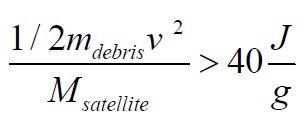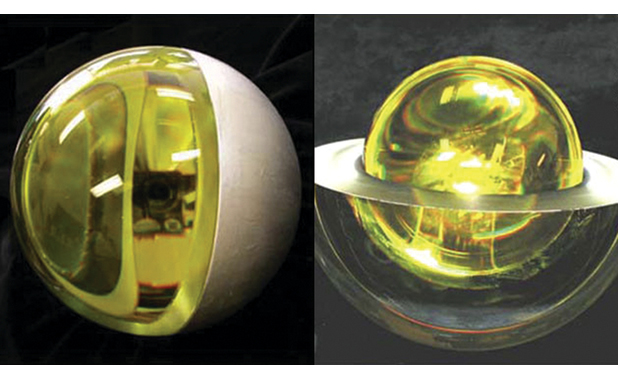One strange effect of the seven Oscar wins yesterday for Alfonso Cuarón’s film Gravity is that many more people will be conversant about something that was mostly the kind of thing specialists talked about—just how damaging space debris from anti-satellite (ASAT) weapons can be. In Gravity, astronauts played by Sandra Bullock and George Clooney struggle for their lives after debris from a satellite destroyed on-orbit by Russia threatens the space shuttle and space station.
While plenty of words have been written about how realistic (or not) Gravity’s science is, space debris from ASAT weapons is a serious problem, with real potential for making the use of some regions of space difficult and expensive. And the space powers have certainly dabbled in live-fire destructive ASAT tests. The Chinese destruction in 2007 of a relatively small satellite, the Fengyun 1C, roughly doubled the debris threat to satellites for the next 5-10 years in the most heavily used part of LEO. But so far, no collisions between debris from ASAT tests and intact satellites are known to have happened.
What Hit the BLITS Satellite?
Though just about a year ago, reports that a piece of debris from the Fengyun 1C satellite collided with a Russian satellite called Ball Lens in the Space (BLITS) circulated widely and made for nice infographics. The claim, reported in generally reputable sources such as CNN and Foreign Policy, was repeated uncritically. It turned out that it just wasn’t true, according to data from US Strategic Command. But the episode (the BLITS satellite, that is, not Gravity) helpfully illuminates a few legal and technical issues about debris collisions.
The Russian scientists minding the BLITS satellite noticed the satellite’s orbit had changed on January 22, 2013 by “a sudden decrease of 120 m in the semi-major axis of its orbit and a change in its spin velocity and attitude.” While this might seem like a minor change, only about the length of a city block, the BLITS satellite is part of the International Laser Ranging Service (ILRS), in which the positions of satellites equipped with retroreflectors are monitored frequently and with great precision. ILRS satellites like BLITS are totally passive and don’t communicate. With little information to go on, the scientists sought help figuring out what might have happened to their satellite.
Via the Center for Space Standards and Innovation (CSSI), a research arm of AGI, Inc., they found a possible explanation. CSSI provides a service called SOCRATES that combs STRATCOM data to predict possible conjunctions of space objects. The CSSI program manager found a tracked object that had a (modestly) close approach to BLITS around the estimated time that it got knocked off course—a piece of debris from the destroyed Fengyun 1C satellite—although he noted that the predicted minimum distance between it and the BLITS satellite was over 3 km. Probably because the CSSI blog called this a “likely collision”, and because space debris is a real concern, and because the intentional destruction of the Fengyun 1C essentially doubled the number of pieces of debris in low earth orbit, the story was reported and repeated without the necessary caveats.
A Suspected Piece of Debris is Cleared
One of these caveats was that a crucial piece of corroborating evidence was missing from the story—if a piece of ASAT debris really did send the BLITS satellite spinning, then the debris too would be knocked off course. But it turns out it wasn’t. On March 21, US Strategic Command’s Joint Space Operations Center (JSPOC) reported the Fengyun debris in question continued along its orbit undisturbed. (JSPOC is the US space traffic management center. It creates the catalogue of space objects that is the gold standard and predicts close approaches as well.) JSPOC stated that “the debris cited in media reports has been unchanged in its orbital track since before January 22, the assessed date of BLITS event” and that “Therefore, the [Jspoc] does not assess it was a likely candidate for causing the BLITS event.”
Using data from Wang Ting’s excellent tool What’s Up one can show graphically that the debris had no sudden movements associated with it. The altitude of the debris’ orbit gradually decayed about 300 m over six months, with no abrupt changes. The black dashed line indicates January 22 when the BLITS satellite was hit by something. It is easy to see that particular piece of debris could not have been the culprit.
Why is this Significant?
China bristled at the suggestion its debris caused the accident and requested proof from the U.S. (even though it wasn’t the U.S. that made the claim, it was an individual analyst).
Even though this particular case didn’t hold water, it is possible to attribute fault for a collision to the country that created the piece of debris (to some degree of certainty). Every one of the thousands of debris pieces that are in the Space Track catalog has its origins identified. (Through subsequent careful analysis, the authors of the original report were able to determine that the problems with BLITS were probably not due to a collision with a piece of tracked debris or spontaneous breakup, but possibly to a piece of debris too small to be tracked.)
To attribute a satellite malfunction to a collision with a piece of tracked debris, a number of pieces of information are useful:
1) any additional debris resulting from the suspected collision could have their orbits traced back, giving an originating time and place of the event
2) an abrupt cease of communications could be used to pinpoint further the collision time (though a completely passive satellite like BLITS does not communicate at all, unfortunately)
3) all tracked debris that happened to be near the time and place of the originating event could be closely examined for changes in orbit, just as in the figure above.
The originator of the debris presumably could be held liable via the Liability Convention, which holds that “States shall be liable for damage caused by their space objects.” David Koplow in his article ”ASAT-isfaction: Customary International Law and the Regulation of Anti-Satellite Weapons” describes the Convention as
a two-tiered tort regime for injury or damage inflicted by a satellite: absolute liability for harm caused on earth or to aircraft, and liability for “fault” for injuries to other countries’ space objects.
No country has yet tried to seek restitution via this convention for damage by space debris to another satellite (as far as I know—readers’ comments welcome here). The BLITS satellite case could be more (or less) complicated legally, since it was a passive satellite and could not maneuver out of the way even if its operators had been giving warning of a possible collision.
The possibility of being held liable is one lever to exert pressure on countries not to foul the space environment with debris; assessing “fault” for a collision with a piece of tracked debris is not an intractable technical or legal problem. It is largely an issue of what kind of resources the international community wishes to bring to bear.
Technical aside: What would a collision with a piece of tracked debris do to the BLITS satellite?
The mass of the BLITS satellite is 8 kg. That’s 17 pounds—a nanosatellite; most satellites are hundreds of kg, big ones are thousands. Consider a collision between a satellite and a piece of debris. NASA provides a relationship that tells you when a collision will be catastrophic and the affected satellite will be completely demolished:
where mdebris is the mass of the piece of debris, Msatellite is the mass of the satellite, and v is the relative velocity. If the two objects were on a crossing orbit, the relative velocity would be roughly 10 km/s. So in a direct hit, a catastrophic collision would have happened if the debris mass were larger than 6.4 g.
If the collision were at a more modest speed of 7 km/s, the debris would still only need to be 13 g to destroy the BLITS satellite.
The smallest piece of debris trackable at the altitude of BLITS will have a radar cross section equal to about a 3-cm sphere. A 3-cm aluminum sphere has a mass of 38 g. This would be more than sufficient to destroy the BLITS satellite in a direct collision, rather than just causing a change in orbit, as was seen for BLITS.
It is conceivable that a piece of debris this size could have provided a glancing blow to the satellite, but BLITS is a poor candidate for such a blow—it doesn’t have any long, sticking-out parts like a solar panel or gravity boom.
In fact, we don’t have to guess as to the mass of the Fengyun debris that was identified as the culprit in the BLITS collision (NORAD ID 30670)—we can make a decent estimate based on its observed radar cross section and the surface area-to-mass ratio inferred from the way its orbit decays over time.
Wang Ting is a careful observer of the orbits of satellites and debris in low-earth orbits, and has calculated the surface area-to-mass ratio of this piece of debris to be about 0.015 m2/kg. The radar cross section published in the Spacetrack catalog is 0.02 m2. This leads to a mass estimate for the Fengyun debris of more than 1 kg. Even before observations showed this piece of debris’ orbit didn’t change and couldn’t have been part of a collision, a calculation like this ought to have made one skeptical: the piece of debris in question is 100 times more massive than it needed to be to have destroyed the satellite in a direct collision.




